Letian Huang
TransparentGS: Fast Inverse Rendering of Transparent Objects with Gaussians
May 01, 2025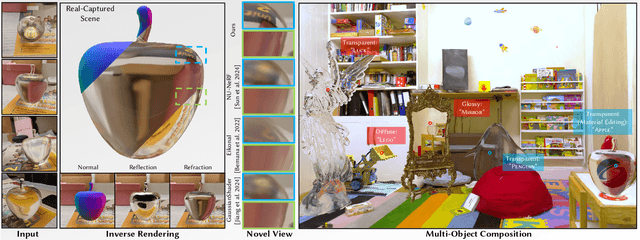

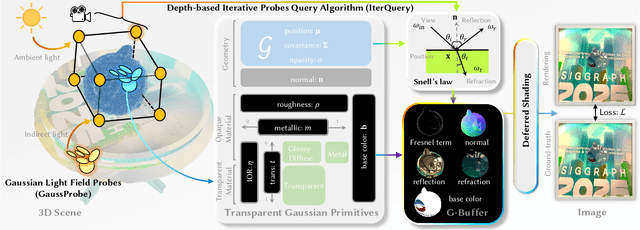
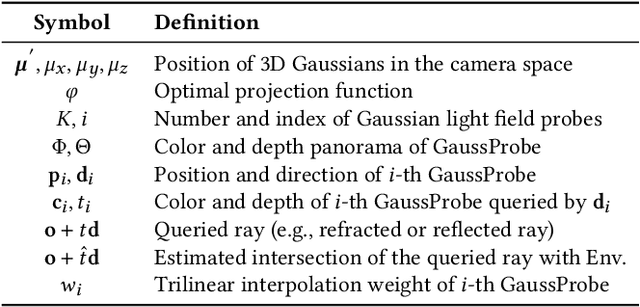
Abstract:The emergence of neural and Gaussian-based radiance field methods has led to considerable advancements in novel view synthesis and 3D object reconstruction. Nonetheless, specular reflection and refraction continue to pose significant challenges due to the instability and incorrect overfitting of radiance fields to high-frequency light variations. Currently, even 3D Gaussian Splatting (3D-GS), as a powerful and efficient tool, falls short in recovering transparent objects with nearby contents due to the existence of apparent secondary ray effects. To address this issue, we propose TransparentGS, a fast inverse rendering pipeline for transparent objects based on 3D-GS. The main contributions are three-fold. Firstly, an efficient representation of transparent objects, transparent Gaussian primitives, is designed to enable specular refraction through a deferred refraction strategy. Secondly, we leverage Gaussian light field probes (GaussProbe) to encode both ambient light and nearby contents in a unified framework. Thirdly, a depth-based iterative probes query (IterQuery) algorithm is proposed to reduce the parallax errors in our probe-based framework. Experiments demonstrate the speed and accuracy of our approach in recovering transparent objects from complex environments, as well as several applications in computer graphics and vision.
GlossyGS: Inverse Rendering of Glossy Objects with 3D Gaussian Splatting
Oct 17, 2024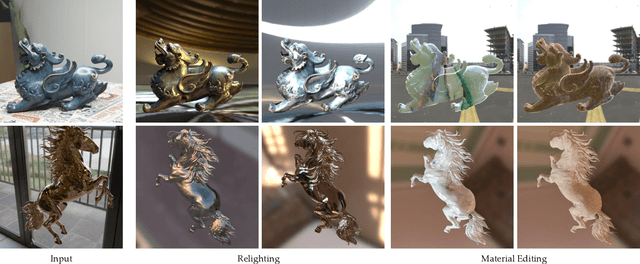

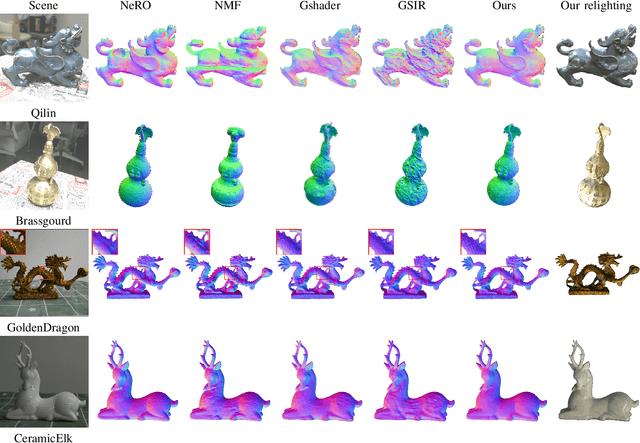

Abstract:Reconstructing objects from posed images is a crucial and complex task in computer graphics and computer vision. While NeRF-based neural reconstruction methods have exhibited impressive reconstruction ability, they tend to be time-comsuming. Recent strategies have adopted 3D Gaussian Splatting (3D-GS) for inverse rendering, which have led to quick and effective outcomes. However, these techniques generally have difficulty in producing believable geometries and materials for glossy objects, a challenge that stems from the inherent ambiguities of inverse rendering. To address this, we introduce GlossyGS, an innovative 3D-GS-based inverse rendering framework that aims to precisely reconstruct the geometry and materials of glossy objects by integrating material priors. The key idea is the use of micro-facet geometry segmentation prior, which helps to reduce the intrinsic ambiguities and improve the decomposition of geometries and materials. Additionally, we introduce a normal map prefiltering strategy to more accurately simulate the normal distribution of reflective surfaces. These strategies are integrated into a hybrid geometry and material representation that employs both explicit and implicit methods to depict glossy objects. We demonstrate through quantitative analysis and qualitative visualization that the proposed method is effective to reconstruct high-fidelity geometries and materials of glossy objects, and performs favorably against state-of-the-arts.
Optimal Projection for 3D Gaussian Splatting
Feb 02, 2024



Abstract:3D Gaussian Splatting has garnered extensive attention and application in real-time neural rendering. Concurrently, concerns have been raised about the limitations of this technology in aspects such as point cloud storage, performance , and robustness in sparse viewpoints , leading to various improvements. However, there has been a notable lack of attention to the projection errors introduced by the local affine approximation inherent in the splatting itself, and the consequential impact of these errors on the quality of photo-realistic rendering. This paper addresses the projection error function of 3D Gaussian Splatting, commencing with the residual error from the first-order Taylor expansion of the projection function $\phi$. The analysis establishes a correlation between the error and the Gaussian mean position. Subsequently, leveraging function optimization theory, this paper analyzes the function's minima to provide an optimal projection strategy for Gaussian Splatting referred to Optimal Gaussian Splatting. Experimental validation further confirms that this projection methodology reduces artifacts, resulting in a more convincingly realistic rendering.
360-GS: Layout-guided Panoramic Gaussian Splatting For Indoor Roaming
Feb 01, 2024



Abstract:3D Gaussian Splatting (3D-GS) has recently attracted great attention with real-time and photo-realistic renderings. This technique typically takes perspective images as input and optimizes a set of 3D elliptical Gaussians by splatting them onto the image planes, resulting in 2D Gaussians. However, applying 3D-GS to panoramic inputs presents challenges in effectively modeling the projection onto the spherical surface of ${360^\circ}$ images using 2D Gaussians. In practical applications, input panoramas are often sparse, leading to unreliable initialization of 3D Gaussians and subsequent degradation of 3D-GS quality. In addition, due to the under-constrained geometry of texture-less planes (e.g., walls and floors), 3D-GS struggles to model these flat regions with elliptical Gaussians, resulting in significant floaters in novel views. To address these issues, we propose 360-GS, a novel $360^{\circ}$ Gaussian splatting for a limited set of panoramic inputs. Instead of splatting 3D Gaussians directly onto the spherical surface, 360-GS projects them onto the tangent plane of the unit sphere and then maps them to the spherical projections. This adaptation enables the representation of the projection using Gaussians. We guide the optimization of 360-GS by exploiting layout priors within panoramas, which are simple to obtain and contain strong structural information about the indoor scene. Our experimental results demonstrate that 360-GS allows panoramic rendering and outperforms state-of-the-art methods with fewer artifacts in novel view synthesis, thus providing immersive roaming in indoor scenarios.
Self-NeRF: A Self-Training Pipeline for Few-Shot Neural Radiance Fields
Mar 10, 2023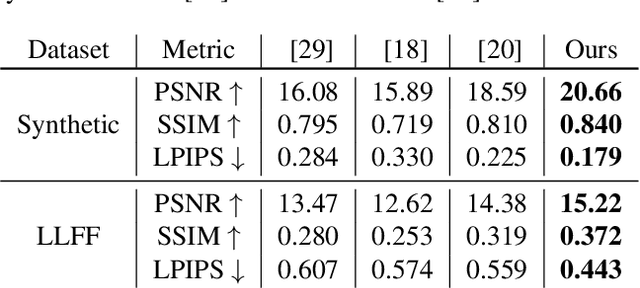

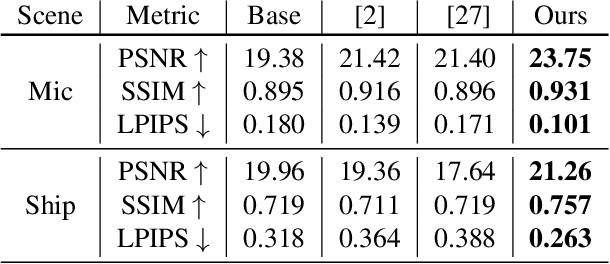

Abstract:Recently, Neural Radiance Fields (NeRF) have emerged as a potent method for synthesizing novel views from a dense set of images. Despite its impressive performance, NeRF is plagued by its necessity for numerous calibrated views and its accuracy diminishes significantly in a few-shot setting. To address this challenge, we propose Self-NeRF, a self-evolved NeRF that iteratively refines the radiance fields with very few number of input views, without incorporating additional priors. Basically, we train our model under the supervision of reference and unseen views simultaneously in an iterative procedure. In each iteration, we label unseen views with the predicted colors or warped pixels generated by the model from the preceding iteration. However, these expanded pseudo-views are afflicted by imprecision in color and warping artifacts, which degrades the performance of NeRF. To alleviate this issue, we construct an uncertainty-aware NeRF with specialized embeddings. Some techniques such as cone entropy regularization are further utilized to leverage the pseudo-views in the most efficient manner. Through experiments under various settings, we verified that our Self-NeRF is robust to input with uncertainty and surpasses existing methods when trained on limited training data.
 Add to Chrome
Add to Chrome Add to Firefox
Add to Firefox Add to Edge
Add to Edge